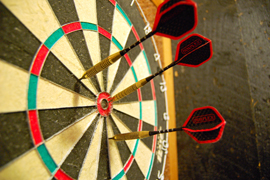CBT and Imagery to Stop Anxiety (Anxious-Avoidance Part II)
The issue is that whilst my internal anxiety alarm* is going off like a Trade Unionist in Wisconsin any other feelings I might have are being drowned out. (*Part I)
Talking about a revolution. Stop anxiety
For all that I may believe in the validity of my anxiety, it comes with far too many unreasonable expectations. I cannot meet them all, which really just makes it a loud, obnoxious sidekick I could do without.
I can't evict my anxiety disorder (chronic PTSD), unfortunately. So I've had to find ways ways to fool it: to get my mind thinking as I may not always believe, or to switch racing, anxious thoughts and frustrations onto a different track.
E.g.
- The more appropriate emotional response to someone being a bit dismissive may be mild irritation, or a couple of butterflies in my tummy.
- Versus thinking that they don't want me around anymore, ever and a screaming blizzard of negative self-talk to go with the sudden onset of panic.
What can you do to escape the cycle of anxiety-avoidance and stop anxiety?
Re-tune the ways your mind responds to that internal all-systems alarm; It will go off but I don't have to respond by thinking it's right. It isn't. It's confused. I can communicate that by "sitting with it".
Anxiety away: Targeted visual thinking
Learning to adjust internal anxiety responses is possible. It's about tuning in, not out!
I visualize a dial, like on an old school TV. I can turn the volume up, or down to adjust how loud my anxiety is; It doesn't have to be so disruptive!
How-to: Cognitive Behavioral Therapy & guided imagery
My felt experience of anxiety is just way too high to accurately reflect the gravity of the situations that set it off. If you don't think that's true for you too, make a list of all the situations you get anxious in and why that may be.
- Are they really as life threatening as that alarm's telling you?
When you first try this, it's a good idea to use a breathing exercise. Practice that, for at least a few minutes, then look inside.
- How and where can you sense your anxiety?
Create as clear a picture of it all as you can; The more detailed the visualization you can create in this exercise, the better.
It's much easier to use visualization techniques when you truly need them, in the midst of panic, if the associative bonds between the visuals and the anxiety are created in a calmer state: Pavlovian mindfulness (Yeah, I totally made that one up).
Approach anxiety
Sense your emotions. Scary as it is to go in search of the things that led to the cycle of anxious-avoidance, duck and cover hasn't stopped anxiety so far, right? Fiddling with the dial just might.
It's OK to try. It's all right there: the dial, your emotions, thoughts, and anxiety. Turn it up, down, or keep your hands off it, whatever you'd like to do! Adjust the dial for just a few seconds before going back to a breathing or relaxation exercise: Rinse, lather, repeat.
Is this going to work, magically, the first time? Unlikely. It takes as much practice as acquiring any other skill. But it works!
As time goes by it began to feel real to me, and I realized how responsive anxiety actually is.
APA Reference
White, K.
(2011, February 24). CBT and Imagery to Stop Anxiety (Anxious-Avoidance Part II), HealthyPlace. Retrieved
on 2025, December 17 from https://www.healthyplace.com/blogs/treatinganxiety/2011/02/cbt-and-imagery-to-stop-anxiety-anxious-avoidance-part-ii
Author: Kate White
Anxiety as cardinal symptom of many psycho-somatic disorders presents acute problem in clinical medicine, particulary in psychiatric ones. Even before 50 years exist many anxiolitic medicaments, the treatment of this psychologic unendurable condition remain unsuccessful. Till now was undertaken some therapeutics approach, amongst which cognitive behavioral thechiques and autogen trenning methods was given the best evidence. In short, the essence of CBT stands in implicit feed-back mechanism between body and mind. It is the power of our mind that recognized relaxation stimuli, both physicaly or psychics, in order to calm an irritate emotional state. This advantage correlation of of psychosomatic interrelationship should emphasize in any temptation to overcome anxiety. The possibility are numerous, practically and without any side harm effect on healthy sstate. Don't miss the opportunity!
